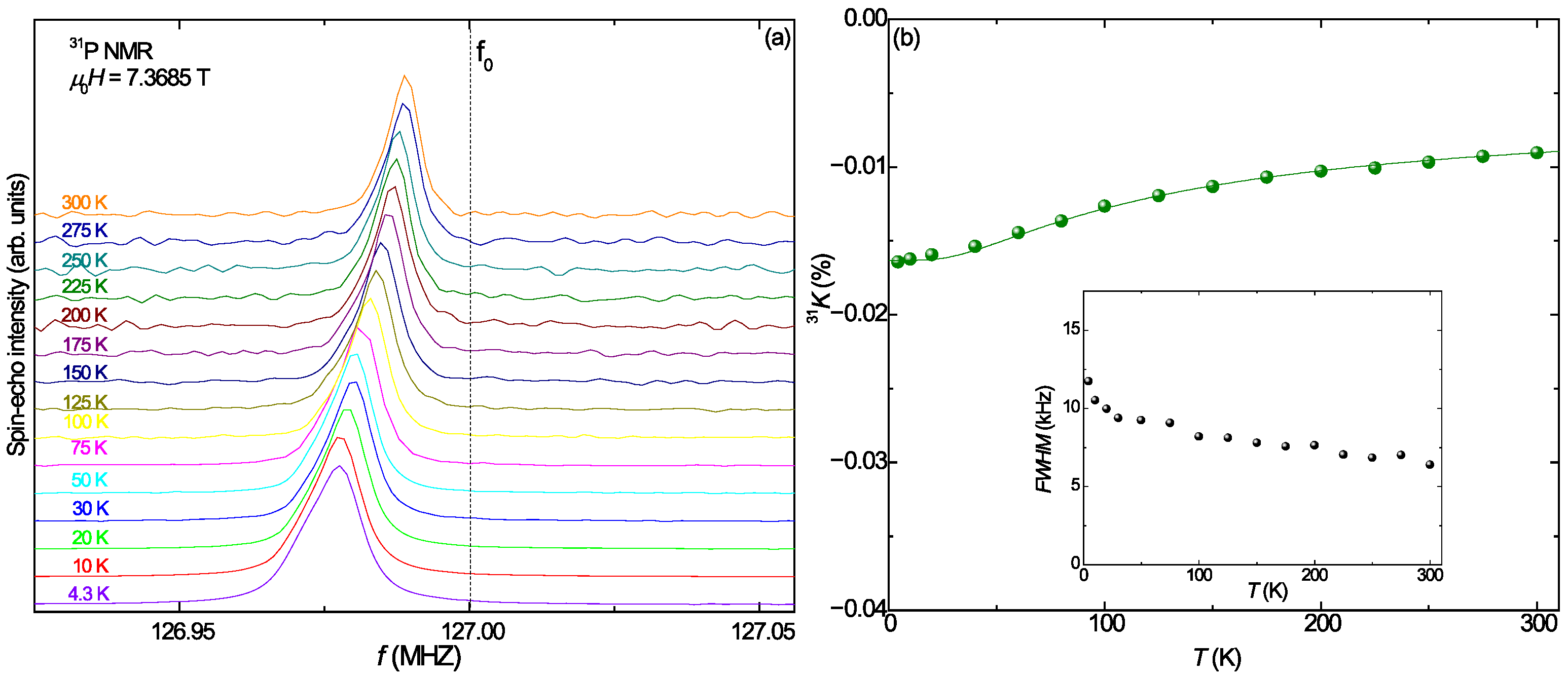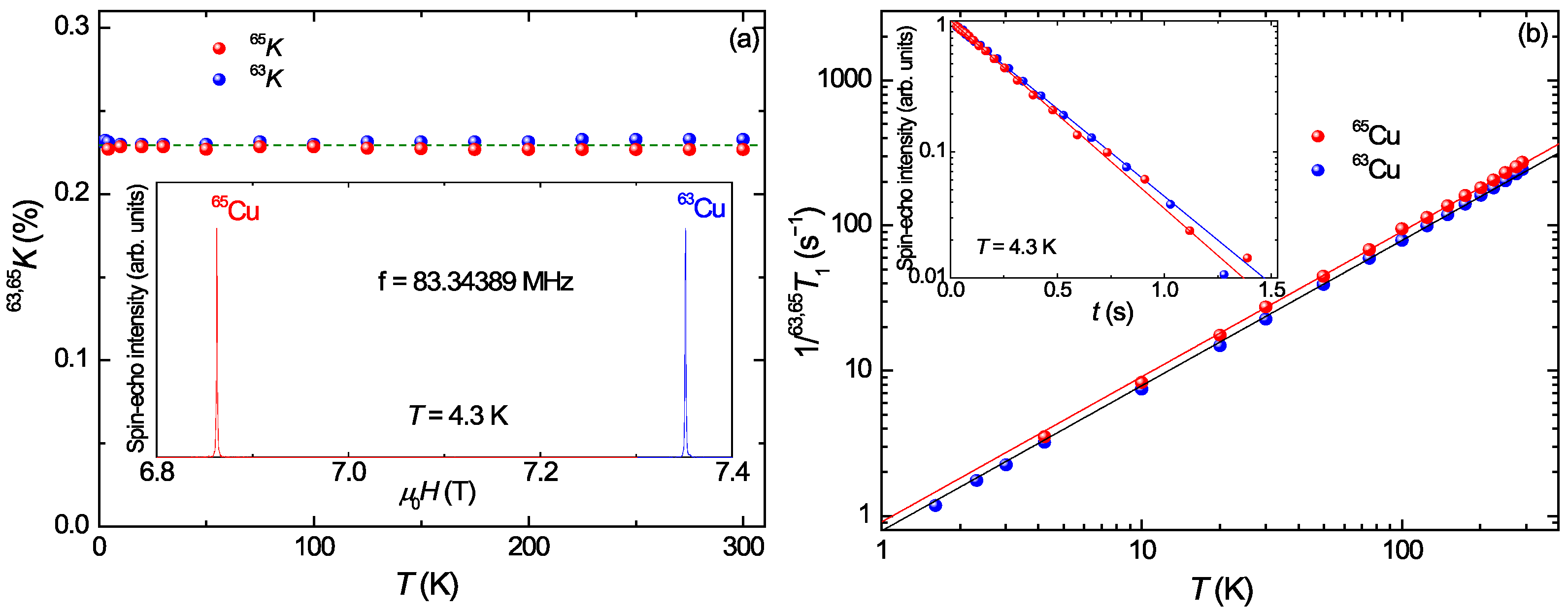Microscopic Characterization of Pb10−xCux(PO4)6O by 31P and 63/65Cu NMR Measurements
Abstract
1. Introduction
2. Materials and Methods
2.1. Material Preparation
2.2. Nuclear Magnetic Resonance
3. Results and Discussion
3.1. 31P NMR Spectra
3.2. Nuclear Spin–Lattice Relaxation Rate 1/31T1 and Nuclear Spin–Spin Relaxation Rate 1/31T2
4. Conclusions
Author Contributions
Funding
Data Availability Statement
Conflicts of Interest
References
- Lee, S.; Kim, J.; Im, S.; An, S.; Kwon, Y.W.; Ho, A.K. Consideration for the development of room-temperature ambient-pressure superconductor (LK-99). J. Korean Cryst. Growth Cryst. Technol. 2023, 33, 61. [Google Scholar]
- Lee, S.; Kim, J.H.; Kwon, Y.W. The First Room-Temperature Ambient-Pressure Superconductor. arXiv 2023, arXiv:2307.12008. [Google Scholar]
- Lee, S.; Kim, J.; Kim, H.T.; Im, S.; An, S.; Auh, K.H. Superconductor Pb10-xCux(PO4)6O showing levitation at room temperature and atmospheric pressure and mechanism. arXiv 2023, arXiv:2307.12037. [Google Scholar]
- Liu, L.; Meng, Z.; Wang, Z.X.; Chen, H.; Duan, Z.; Zhou, X.; Yan, H.; Qin, P.; Liu, Z. Semiconducting Transport in Pb10−XCux(PO4)6O Sintered from Pb2SO5 and Cu3P. Adv. Funct. Mater. 2023, 33, 2308938. [Google Scholar] [CrossRef]
- Kumar, K.; Karn, N.K.; Awana, V.P.S. Synthesis of possible room temperature superconductor LK-99: Pb9Cu(PO4)6O. Supercond. Sci. Technol. 2023, 36, 10LT02. [Google Scholar] [CrossRef]
- Hou, Q.; Wei, W.; Zhou, X.; Wang, X.; Wang, T.; Sun, Y.; Shi, Z. Synthesis, transport and magnetic properties of Cu-doped apatite Pb10−xCux(PO4)6O. Matter 2023, 6, 4408–4418. [Google Scholar] [CrossRef]
- Zhu, S.; Wu, W.; Li, Z.; Luo, J. First-order transition in LK-99 containing Cu2S. Matter 2023, 6, 4401–4407. [Google Scholar] [CrossRef]
- Jain, P.K. Superionic Phase Transition of Copper(I) Sulfide and Its Implication for Purported Superconductivity of LK-99. J. Phys. Chem. C 2023, 127, 18253–18255. [Google Scholar] [CrossRef]
- Guo, K.; Li, Y.; Jia, S. Ferromagnetic half levitation of LK-99-like synthetic samples. Sci. China Phys. Mech. Astron. 2023, 66, 107411. [Google Scholar] [CrossRef]
- Wu, H.; Yang, L.; Xiao, B.; Chang, H. Successful growth and room temperature ambient-pressure magnetic levitation of LK-99. arXiv 2023, arXiv:2308.01516. [Google Scholar]
- Wang, P.; Liu, X.; Ge, J.; Ji, C.; Ji, H.; Liu, Y.; Ai, Y.; Ma, G.; Qi, S.; Wang, J. Ferromagnetic and insulating behavior in both half magnetic levitation and non-levitation LK-99 like samples. Quantum Front. 2023, 2, 10. [Google Scholar] [CrossRef]
- Lai, J.; Li, J.; Liu, P.; Sun, Y.; Chen, X.Q. First-principles study on the electronic structure of Pb10−xCux(PO4)6O (x = 0, 1). J. Mater. Sci. Technol. 2024, 171, 66. [Google Scholar] [CrossRef]
- Griffin, S.M. Origin of correlated isolated flat bands in copper-substituted lead phosphate apatite. arXiv 2023, arXiv:2307.16892. [Google Scholar]
- Si, L.; Held, K. Electronic structure of the putative room-temperature superconductor Pb9Cu(PO4)6O. Phys. Rev. B 2023, 108, L121110. [Google Scholar] [CrossRef]
- Kurleto, R.; Lany, S.; Pashov, D.; Acharya, S.; Schilfgaarde, M.V.; Dessau, D.S. Pb-apatite framework as a generator of novel flat-band CuO based physics. arXiv 2023, arXiv:2308.00698. [Google Scholar]
- Cabezas-Escares, J.; Barrera, N.F.; Cardenas, C.; Munoz, F. Electronic structure and vibrational stability of copper-substituted lead apatite LK-99. Phys. Rev. B 2024, 109, 144515. [Google Scholar] [CrossRef]
- Tao, K.; Chen, R.; Yang, L.; Gao, J.; Xue, D.; Jia, C. The 1/4 occupied O atoms induced ultra-flatband and the one-dimensional channels in the Pb10−xCux(PO4)6O4 (x = 0, 0.5) crystal. APL Mater. 2024, 12, 021120. [Google Scholar] [CrossRef]
- Jiang, Y.; Lee, S.B.; Herzog-Arbeitman, J.; Yu, J.; Feng, X.; Hu, H.; Călugăru, D.; Brodale, P.S.; Gormley, E.L.; Vergniory, M.G.; et al. Pb9Cu(PO4)6(OH)2: Phonon bands, localized flat-band magnetism, models, and chemical analysis. Phys. Rev. B 2023, 108, 235127. [Google Scholar] [CrossRef]
- Liu, R.; Guo, T.; Lu, J.; Ren, J.; Ma, T. Different phase leads to different transport behavior in Pb9Cu(PO4)6O compounds. Int. J. Mod. Phys. C 2025, 36, 7. [Google Scholar] [CrossRef]
- Yang, S.; Liu, G.; Zhong, Y. Ab initio investigations on the electronic properties and stability of Cu-substituted lead apatite (LK-99) family with different doping concentrations (x = 0, 1, 2). Mater. Today Commun. 2023, 37, 107379. [Google Scholar] [CrossRef]
- Paudyal, H.; Flatt’e, M.E.; Paudyal, D. Implications of the electron-phonon coupling in CuPb9(PO4)6O for superconductivity: An ab initio study. Phys. Rev. Mater. 2024, 8, L011801. [Google Scholar] [CrossRef]
- Pashov, D.; Acharya, A.; Lany, S.; Dessau, D.S.; Schilfgaarde, M.V. Multiple Slater determinants and strong spin-fluctuations as key ingredients of the electronic structure of electron- and hole-doped Pb10−xCux(PO4)6O. arXiv 2023, arXiv:2308.09900. [Google Scholar]
- Shimizu, M.; Otsuki, J.; Jeschke, H.O. Magnetic fluctuations in Pb9Cu(PO4)6O. Phys. Rev. B 2023, 108, L201105. [Google Scholar] [CrossRef]
- Witt, N.; Si, L.; Tomczak, J.M.; Held, K.; Wehling, T.O. No superconductivity in Pb9Cu1(PO4)6O found in orbital and spin fluctuation exchange calculations. SciPost Phys. 2023, 15, 197. [Google Scholar] [CrossRef]
- Zhang, Y.; Liu, C.; Zhu, X.; Wen, H.-H. Ferromagnetism and insulating behavior with a logarithmic temperature dependence of resistivity in Pb10−xCux(PO4)6O. Sci. China Phys. Mech. Astron. 2024, 67, 217413. [Google Scholar] [CrossRef]
- Wolf, D. Spin Temperature and Nuclear-Spin Relaxation in Matter, 1st ed.; Oxford University Press: Oxford, UK, 1979. [Google Scholar]
- Taylor, R.E.; Alkan, F.; Koumoulis, D.; Lake, M.P.; King, D.; Dyowski, C.; Bouchard, L.-S. A Combined NMR and DFT Study of Narrow Gap Semiconductors: The Case of PbTe. J. Phys. Chem. C 2013, 117, 8959–8967. [Google Scholar] [CrossRef]
- Koumoulis, D.; Leung, B.; Chasapis, T.C.; Taylor, R.; King, D.; Kanatzidis, M.G.; Bouchard, L.-S. Understanding Bulk Defects in Topological Insulators from Nuclear-Spin Interactions. Adv. Funct. Mater. 2014, 24, 1519–1528. [Google Scholar] [CrossRef]
- Park, J.K.; Kang, D.H.; Park, S.K.; Lee, J.S. NMR probe of suppressed bulk conductivity in the topological insulator Bi0.5Sb1.5Te3. RSC Adv. 2022, 12, 2531. [Google Scholar] [CrossRef]
- Singh, M.; Saha, P.; Kumar, K.; Takhar, D.; Birajdar, B.; Awana, V.P.S.; Patnaik, S. Electromagnetic properties of copper doped lead apatite Pb10−xCux(PO4)6O. J. Mater. Sci. 2024, 59, 1464–1471. [Google Scholar] [CrossRef]
- Carter, G.C.; Bemmett, L.H.; Karha, D.J. Metallic Shifts in NMR: A Review of the Theory and Comprehensive Critical Data Compilation of Metallic Materials; Pergamon Press: Oxford, UK; New York, NY, USA; Toronto, ON, Canada; Sidney, Australia; Paris, France; Frankfurt, Germany, 1977. [Google Scholar]
- Furo, I.; Bakonyi, I.; Tompa, K.; Zsoldos, E.; Heinmaa, I.; Alla, M.; Lippmma, E. 31P nuclear magnetic resonance Knight shift and linewidth in Ni3P and Cu3P: A magic-angle spinning study. J. Phys. Condens. Matter 1990, 2, 4217. [Google Scholar] [CrossRef]
- Liu, C.; Cheng, W.; Zhang, X.; Xu, J.; Li, J.; Shi, Q.; Yuan, C.; Xu, L.; Zhou, H.; Zhu, S.; et al. Phases and magnetism at microscale in compounds containing nominal Pb10−xCux(PO4)6O. Phys. Rev. Mater. 2023, 7, 084804. [Google Scholar] [CrossRef]
- Kumar, K.; Karn, N.K.; Kumar, Y.; Awana, V.P.S. Absence of Superconductivity in LK-99 at Ambient Conditions. ACS Omega 2023, 8, 41737–41743. [Google Scholar] [CrossRef]
- Puphal, P.; Akbar, M.Y.P.; Hepting, M.; Goering, E.; Isobe, M.; Nugroho, A.A.; Keimer, B. Single crystal synthesis, structure, and magnetism of Pb10−xCux(PO4)6O. APL Mater. 2023, 11, 101128. [Google Scholar] [CrossRef]



Disclaimer/Publisher’s Note: The statements, opinions and data contained in all publications are solely those of the individual author(s) and contributor(s) and not of MDPI and/or the editor(s). MDPI and/or the editor(s) disclaim responsibility for any injury to people or property resulting from any ideas, methods, instructions or products referred to in the content. |
© 2025 by the authors. Licensee MDPI, Basel, Switzerland. This article is an open access article distributed under the terms and conditions of the Creative Commons Attribution (CC BY) license (https://creativecommons.org/licenses/by/4.0/).
Share and Cite
Ding, Q.-P.; Sun, Y.; Hou, Q.; Wei, W.; Zhou, X.; Wang, X.; Shi, Z.; Furukawa, Y. Microscopic Characterization of Pb10−xCux(PO4)6O by 31P and 63/65Cu NMR Measurements. J. Compos. Sci. 2025, 9, 377. https://doi.org/10.3390/jcs9070377
Ding Q-P, Sun Y, Hou Q, Wei W, Zhou X, Wang X, Shi Z, Furukawa Y. Microscopic Characterization of Pb10−xCux(PO4)6O by 31P and 63/65Cu NMR Measurements. Journal of Composites Science. 2025; 9(7):377. https://doi.org/10.3390/jcs9070377
Chicago/Turabian StyleDing, Qing-Ping, Yue Sun, Qiang Hou, Wei Wei, Xin Zhou, Xinyue Wang, Zhixiang Shi, and Yuji Furukawa. 2025. "Microscopic Characterization of Pb10−xCux(PO4)6O by 31P and 63/65Cu NMR Measurements" Journal of Composites Science 9, no. 7: 377. https://doi.org/10.3390/jcs9070377
APA StyleDing, Q.-P., Sun, Y., Hou, Q., Wei, W., Zhou, X., Wang, X., Shi, Z., & Furukawa, Y. (2025). Microscopic Characterization of Pb10−xCux(PO4)6O by 31P and 63/65Cu NMR Measurements. Journal of Composites Science, 9(7), 377. https://doi.org/10.3390/jcs9070377






